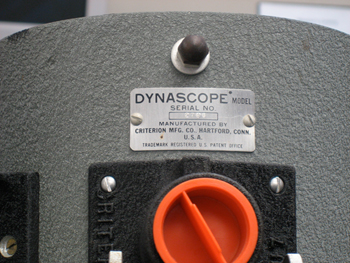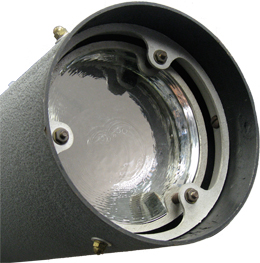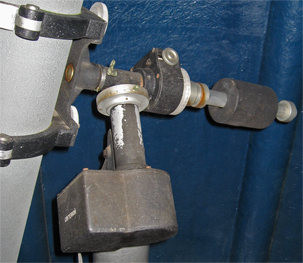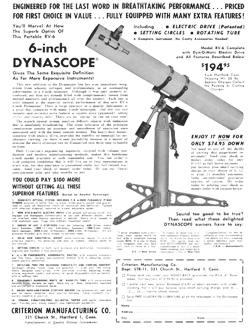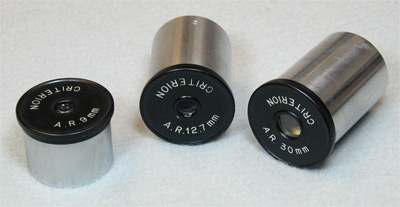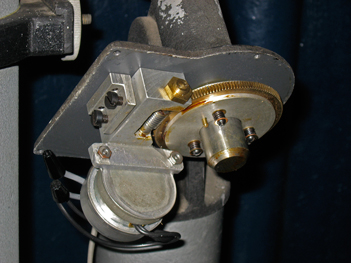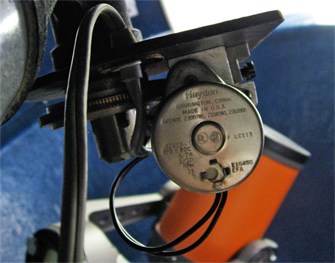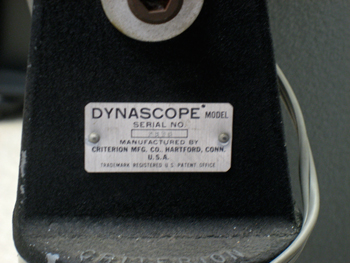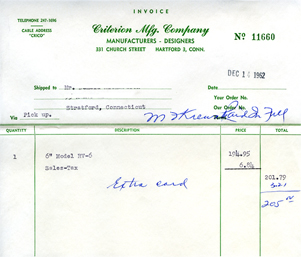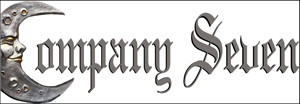
Criterion RV-6 Dynascope®
“these introduced many of us to visual astronomy”
-
A discontinued product, posted for information purposes by Company Seven.
The RV-6’s illustrated here are from Criterion literature and an RV-6 that is in Company Seven’s museum collection of telescopes.

Preface In January 2008 Company Seven added a Criterion RV-6 Dynascope to our museum collection. The RV-6 Dynascope is a six inch (6") aperture 1,270mm focal length f/8 Newtonian reflecting optical tube assembly mated onto the Dynascope model German Equatorial Mount. This was a commercial product manufactured by Criterion Manufacturing, Inc., among the first few U.S. based producers of complete good quality amateur telescopes who operated from the 1950’s to the 1980’s. The instrument was geared to the amateur and school markets with a goal of maintaining a modest price.
Right: the Criterion Dynascope RV-6 Telescope of 1962. The tube assembly is painted dark gray, the pier is silver gray (26,234 bytes).
Click on image to see enlarged view (61,033 bytes).
Company Seven had been on the lookout to acquire an RV-6 for display since we know it is among the landmark telescopes that gave thousands of people their introduction to visual astronomy. The founder of Company Seven fondly recalls seeing the Moon through the first telescope he ever encountered, a 6 inch reflector:
-
“I was so young then that I can not recall when it was, but I happened across a neighbor in our playground who had set up what was probably a Criterion RV-6. He let me and others look through his telescope at the Moon, maybe only for moments but I have never forgot that sense of awe and fascination that came over me! That was the beginning of my affection for this hobby, and of my fondness for making a similar experience attainable for others. For years following that night I could only afford to sketch telescopes. I hoped for a future where I might be able to buy an RV-6, or if I became successful then maybe I would be able to buy an RV-8 the 8 inch f/6 telescope. And if I graduated college and became rich then I might buy the 12-½ inch f/6 observatory class telescope! I imagined each telescope loaded up with every imaginable accessory: multiple finders, photoguide telescopes, eyepieces, drives and correctors, every manner of piece part. Decades later I own telescopes and technologies that nobody imagined could be made when I was young. But regardless of all my fantastic state of the art telescopes, CCD cameras, go-to this and that, I do not smile quite the same way as when I look upon an RV-6”
The particular unit acquired by Company Seven was represented to us as being “in excellent condition”, complete and fully documented even with the original Invoice dated December 14, 1962. The original cost of the set was $194.95, plus 3-½% State Sales Tax, and with an extra Cord added at the last minute this amounted to $205.00.
- Haydon Mfg. Co. (then of Torrington, CT) AC powered geared synchronous motor coupled to a helical Worm Wheel that drives the main Worm Gear. The motor is powered by 115 volt AC 60 cycle current (wall current, or for convenience in the field by batteries through an Inverter or a Drive Corrector), simply plug the two prong cord into an outlet and the drive is on! An optional Drive Corrector permits the user to vary the AC current frequency to the motor thereby adjusting its speed; by doing so one can set the rate to Sidereal, and possibly to Solar and Lunar rates. More advanced Drive Correctors designed for astrophotography incorporate “Periodic Error Control” circuits to program in compensations for eccentricities of the Worm Wheel.
A number of people who have refurbished their Dynascope replace the original two prong AC power cord with a modern three conductor cord that includes a Ground terminal. If you visit the RV-6 Restoration Gallery then you can see details of how this is done. Incidentally for safety, Company Seven recommends that when using any telescope from AC wall current that the outlet (or the entire circuit) should be wired on a Ground Fault Curcuit Interruptor (GFCI).
Those who need to replace a motor will find similar units are made by companies including Hurst Manufacturing and by Synchron Motors of Hansen Corporation.
- Worm Gear set providing a large gear reduction and that translates into torque! The Worm is installed within a metal bearing block and this assembly is maintained aligned at ninety degrees to and in tension against the Worm Wheel Gear by a spring loading mechanism that helps to keep the backlash consistently minimized regardless of temperature changes. Worm gears have an interesting property that no other gear set has, and that is the Worm can easily turn the Wheel Gear but the Wheel Gear cannot turn the worm. This is because the angle on the Worm is so shallow that when the Wheel Gear tries to spin it, the friction between the Wheel Gear and the Worm holds the Worm in place. The locking feature act as a brake for the Right Ascension drive of the Dynascope mount when the motor is not turning.
The Worm Wheel gear has 144 teeth. The AC motor spindle rotates at a rate of 1/10 revolution per minute thus advancing the Wheel by one tooth every ten minutes; this is one revolution every 1,440 minutes (24 hours) the period of one Mean Solar Day. Incidentally, this is a bit slower than the Sidereal rate by 3 minutes and 56 seconds per day.
- The ’Dyn-O-Matic’ drive clutch provides the user with the capability to have the telescope motor turned on with the telescope tracking automatically, then the user can grasp the telescope optical tube and manually move it across the sky without the Worm Gear restricting the movement. This slip clutch assembly consists of the Worm Wheel gear disc sandwiched on either side by a cork ring shaped washer, this in turn is sandwiched between two machined aluminum pressure plates. The tension on the clutch is regulated by three spring loaded screws threaded from one pressure plate into another that bind the assembly together. The cork and spring loading compensate for changes of temperature and wear over time to maintain a consistent alignment of the Worm Wheel and Worm Gear.
- The 1962 RV-6 Dynascope mount in Company Seven’s collection features a Declination Axis manual control; this is illustrated in the image of our mount above. This consists of a hand knob protruding from the Housing attached to a gear and clutch assembly within. By turning the knob clockwise or back this turns the Worm and that permits the operator to make fine adjustments to the Declination axis. This is helpful particularly since with the R.A. axis reasonably well Polar Aligned and the motor tracking, the only shift of the object in view would be in the Dec Axis and this would be continuous and in only one direction (North or South) depending on the latitude (elevation) error of the Pole Alignment. The original sales receipt does not mention this feature nor do the advertisements, and so this may have been standard with all of these mounts made at the time or the owner may have ordered it after the original sale.
- Setting Circles were provided on the mount, the Declination Circle (in degrees) would be set at the factory and its orientation to the mount would never change. The Right Ascension Circle (hours and minutes) however was on a clutch so that when the instrument was assembled and the mount Pole Aligned, the telescope could be pointed onto a known object and the Right Ascension circle dialed to the indicator to correspond with the coordinate of the object. These are machined of aluminum and engraved for durability and longevity.
 “Criterion RV Dynascope Instruction Manual” Scan of an original eight* page document as provided by Criterion Manufacturing Company with an RV-6 Dynascope telescope sold in about 1977 (in Acrobat Reader .pdf format) provided for information and interesting reading. The original document is largely typed and mimeographed or photocopied, with the pages printed on one side then stapled together. Even though this is clearly an original English document and not a poor translation to accompany an imported telescope, this is typical of the kind of documentation that accompanied telescopes of this time: moderately illustrated and not the best at conveying some aspects of how to use the telescope. We have no way of being certain this document is complete, nor can we say for sure the period over which this document was included with the RV telescopes. But the document refers to the change in standard equipment of from two small to one larger counterweights, this happened by the time the 1962 model RV-6 displayed in our collection was constructed so it is possible that at least some pages of this document were unchanged from that time.
“Criterion RV Dynascope Instruction Manual” Scan of an original eight* page document as provided by Criterion Manufacturing Company with an RV-6 Dynascope telescope sold in about 1977 (in Acrobat Reader .pdf format) provided for information and interesting reading. The original document is largely typed and mimeographed or photocopied, with the pages printed on one side then stapled together. Even though this is clearly an original English document and not a poor translation to accompany an imported telescope, this is typical of the kind of documentation that accompanied telescopes of this time: moderately illustrated and not the best at conveying some aspects of how to use the telescope. We have no way of being certain this document is complete, nor can we say for sure the period over which this document was included with the RV telescopes. But the document refers to the change in standard equipment of from two small to one larger counterweights, this happened by the time the 1962 model RV-6 displayed in our collection was constructed so it is possible that at least some pages of this document were unchanged from that time.
This is the scanned copy of original document* from Company Seven’s Archives (717,437 bytes with our Cover Sheet), the telescope this document accompanied also resides in our collection through the generosity of E. De La Pena.
*Curiously enough there were two copies of Page 5 one poor and another better, this may be as it was provided by the factory. We provide only the better of the two pages in this .pdf.
If you are a novice who has acquired a telescope such as this then instead of relying on this manual alone, we urge you to look for better written contemporary observational astronomy guide books (Nighwatch for example) and affiliate yourself with an astronomy club.
Above: the Criterion RV-6 telescope in the Company Seven Museum Collection. This instrument is complete as it was picked up by the
customer at the factory in December 1962. Note sometime after 1967 Criterion discontinued serializing OTA’s and put a plate on the Mount only.
Click on images to see enlarged views (296,868 and 229,679 bytes).
And if it was provided with the telescope, then the instruction manual was not provided to us. Since our general policy is to conserve antiques, we display this telescope among our collection at our showroom cleaned but otherwise not restored. However, for those who are interested in seeing how a telescope like this comes together, please browse our Criterion RV-6 Dynascope Restoration Gallery where Mr. Tom McDonough shows us in a series of images how over the course of several months he disassembled, refinished and upgraded his RV-6.
Background: Criterion Mfg., Inc. The Criterion Co. was established at 331 Church Street, Hartford 3, Connecticut by Mr. John Krewalk, Sr. In time it became Criterion Manufacturing Company, Inc. His son John J. Krewalk (b. 1950) would in time come to work for the company too. The sales invoice provided with the RV-6 owned by Company Seven indicates the telephone number then was 247-1696, and their Cable address was “CRICO”.
The first telescope offered by the Criterion Co. was the 1954 model 1.6 inch (40mm) aperture f/25 achromatic refracting telescope. This included three eyepieces providing 40, 80 and 111x. Resembling a walking stick it was provided on a simple alt-az (altitude and azimuth, or pan and tilt) mount and tripod standing about 5 feet tall and selling for $26.95. Some months after the 1.6 inch telescope was made available Criterion announced the first Dynascope, a four inch (4") Newtonian Reflecting telescope that sold with three eyepieces in 1954 for $44.95 plus shipping. As telescope mounts and accessories were improved then the costs escalated accordingly. Do not overlook the fact that telescopes such as these were still rather costly luxury items at a time when the monthly rent might be $150 per month or less. And this was well before credit cards so by 1956 Criterion (among other telescope makers) offered time payment plans of up to twenty four months. Some of us at Company Seven still recall still offering simple payment plan options for customers ordering a Questar telescope (also introduced in 1954) as late as the mid 1980’s.
By 1955 the first commercial 6 inch f/8 Newtonian telescope became available, made by competitor Edmund Salvage Co. this no doubt put pressure on Criterion to respond. And Criterion may have already had their response in the works since in the December 1956 issue of Sky and Telescope they announced the new series of Newtonian telescopes. This would initially include the Dynascope 6 inch with either a German mount with wood tripod or a deluxe German mount and with a massive steel pier, and the line grew to feature models of as large as 16 inch aperture. Resembling the flared bell of a trumpet the deluxe massive pier-mounted 6 inch Newtonian telescope cost $475!
The RV-6 Dynascope Several versions of the Dynascope 6 telescope were produced but the RV-6 that would come to dominate its class would not appear until January 1959 when Criterion’s two page spread in Sky and Telescope revealed it:
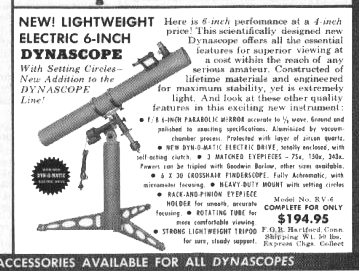
“NEW! LIGHTWEIGHT ELECTRIC 6-INCH DYNASCOPE.
With Setting Circles- New Addition to the DYNASCOPE Line!”
Here is 6-inch performance at a 4-inch price! This scientifically designed new Dynascope offers all the essential features for superior viewing at a cost within the reach of any serious amateur. Constructed of lifetime material and engineered for maximum stability, yet is extremely light. And look at these other quality features in this exciting new instrument:
• f/8 6-INCH PARABOLIC MIRROR accurate to ⅛ wave. Ground and polished to exacting specifications. Aluminized by vacuum-chamber process. Protected with layer of silicon quartz.
• NEW SYN-O-MATIC ELECTRIC DRIVE totally enclosed, with self-acting clutch.
• 3 MATCHED EYEPIECES - 75x, 150x, 341x. Powers can be tripled with Goodwin Barlow, other sizes available.
• 6 x 30 CROSSHAIR FINDERSCOPE. Fully Achromatic, with micrometer focusing.
• HEAVY-DUTY MOUNT with setting circle
• RACK-AND-PINION EYEPIECE HOLDER for smooth accurate focusing.
• ROTATING TUBE for more comfortable viewing.
• STRONG LIGHTWEIGHT TRIPOD for sure, steady support.
Model No. RV-6 COMPLETE FOR ONLY $194.95 F.O.B. Hartford, Conn. Shipping Wt. 55 lbs. Express Chgs. Collect".
After finally adding a Criterion RV-6 to our own collection Company Seven observed that almost all the early images that we have seen published advertising the Criterion RV-6 show:
-
1. both the telescope optical tube and mount appeared reversed,
2. the optical tube shown is not a RV-6. These early images may have shown a mock up of the RV-6 or a poorly scaled image,
3. the counterweight shaft above and then below the counterweight are different diameters,
4. the counterweight shown would be inadequately light to balance an actual RV-6.
* The “rotating tube” mentioned in these RV-6 advertisements is a term that is by todays standards misleading. The optical tube is held onto the German mount saddle plate by means of two hinged clamping mounting rings. By loosening the ring clamps it was possible to rotate the telescope tube so that during the course of observing one then another objects in various areas of the night sky, the focuser with eyepiece could be rotated to a more accessible position. In practice, the early RV-6 tube exteriors where very textured, and this made it impossible to rotate the tube unless the ring clamps were loosened almost fully. By the 1980’s rotating ring hardware sets were available for amateur Newtonian telescopes that were more practical moving smoothly and with clutches for adjustable drag or locking into place, and these were more precise at keeping the telescope tube optical axis more closely parallel to that of the mount’s axis of rotation.
The Criterion RV-6 was delivered or it could be picked up at the factory assembled with the optics collimated. It was provided with a 6x 30mm Finderscope, with a rack and pinion 1.25 inch Focuser to accommodate the customers choice of three eyepieces, with electric motorized clock drive, Right Ascension and Declination Setting Circles, and a complete money back guarantee.
The price of $194.95 in 1959 had about the same buying power as $1,419.00 in 2008. Annual inflation over this period was about 4.13%. So the customer could choose to pay the instrument in full, or pay a deposit with the balance paid in monthly installments over 6, 12, 18 or 24 months.
 Optics Several optical shops became established in the late 1940’s and early 1950’s founded by craftsmen who learned their skills working in the armaments industry. These shops produced consistently good industrial quality optics at a comparatively modest cost, and it was these companies who made the optics sold to Criterion as well as to its competitors including Edmund Scientific, and Cave Co. Our Criterion RV-6 Dynascope Restoration Gallery with images by Mr. Tom McDonough shows a certification label of one of these subcontractors (UPCO OPTICS) attached to the Primary Mirror. Criterion would continue to source their optics design services and components from optics fabricators in the USA until Criterion began to explore ways to make optics for their “Dynamax 8" catadioptric telescope introduced in 1971.
Optics Several optical shops became established in the late 1940’s and early 1950’s founded by craftsmen who learned their skills working in the armaments industry. These shops produced consistently good industrial quality optics at a comparatively modest cost, and it was these companies who made the optics sold to Criterion as well as to its competitors including Edmund Scientific, and Cave Co. Our Criterion RV-6 Dynascope Restoration Gallery with images by Mr. Tom McDonough shows a certification label of one of these subcontractors (UPCO OPTICS) attached to the Primary Mirror. Criterion would continue to source their optics design services and components from optics fabricators in the USA until Criterion began to explore ways to make optics for their “Dynamax 8" catadioptric telescope introduced in 1971.
Right: Image by Mr. Tom McDonough showing the “UPCO OPTICS” label on the back of his Criterion Dynascope RV-6 Primary Mirror (64,089 bytes).
The Primary Mirror of the RV-6 in Company Seven’s collection has no identification of the source of the mirror, but has focal length 50" etched on the back surface.
Click on image to enlarged the view and read the print (120,247 bytes).
A good measure of the success of the Criterion telescopes of this time were the high performance of their optics. While meeting the optical prescription of the proper curve is important, it is critical that the surface be polished to be consistently smooth as well. In all fairness it is not as complicated a matter to figure (grind and polish) the Primary Mirror of a reflecting telescope at f/8 so that it will perform well enough to impress most buyers as it is to make a mirror do well at faster ratios of f/6 or f/5 since the mirrors of an f/8 reflector can made almost spherical. And the comparatively long focal ratio means the telescope can provide stunningly clear images across the field of view even when operating with comparatively simple eyepieces. The Criterion Primary Mirror substrate is Pyrex® which is arguably better than necessary for a small f/8 telescope, but it is a choice indicative of caring by management and not of pinching pennies.
-
One of the older employees of Company Seven commented “I never saw a bad set of optics in those early Criterion telescopes”.
It may be that when we were young we were naive, or it may be these were well made optics - that truth is: this will not matter since
these telescopes served their purpose, and did so affordably.
Right: click on this image to see the full page advertisement of 1960 showing the Criterion Dynascope RV-6 Telescope apparently with a white OTA (60,316 bytes).
Click on image to see enlarged view (399,423 bytes).
Eyepieces The brochure accompanying our RV-6 listed these as choices of Achromatic Ramsden and Orthoscopic eyepieces: AR 18mm - 65x, AR 12.7mm - 100x, AR 9mm - 150X, OR 6mm 200X, or OR 4mm 320X. The Carl Zeiss designed Achromatic Ramsden (sometimes termed ’Modified Achromatic’ and similar to the Kellner) are good economical general purpose eyepieces when made well. While the Orthoscopic (another Zeiss design) may be highly regarded for its uniformity of magnification across the field of view, combined with very good to superb contrast and definition thereby making it a good choice for observing planets for example. The telescope in Company Seven’s collection came with the original three 1.25 inch diameter eyepieces wrapped in tissue within one cardboard box.
Left: Original eyepieces provided with the RV-6 Dynascope in our collection:
Click on the image to see enlarged view (100,004 bytes).
Criterion A.R. 30mm - providing about a 1 degree actual field of view at 42X
Criterion A.R. 12.7mm - about ½ degree actual field of view at 100X
Criterion A.R. 9mm - ¼ degree actual field of view at degree 150X
There were other eyepieces sold for the Criterion telescopes, these might bear the their Cable address “CRICO" as a trademark. The offerings included some upscale Erfle eyepieces. It is surprising to find this affordably priced telescope was furnished with well constructed eyepieces and of the larger 1.25 inch diameter since at the time and throughout the 1960’s into the 1980’s most other ’beginner telescopes’ were provided with 0.965 inch diameter eyepieces. And it was rare that amateur eyepieces would be found to have been mechanically as well made as these. The interior of each barrel is painted anti-reflection black but we do note however, this telescope’s Criterion eyepiece barrels were not fashioned to accept thread-on filters.
The optical tube is made of Bakelite (pronounced ’Bay-Kah-Lite’) tube. Bakelite is the world’s first plastic, a formulated synthetic resin named after Dr. Leo Baekeland the Belgian-American chemist who invented it around 1909. It is thermally stable, resistant to moisture, lightweight, rigid and non-conductive; these properties made it a natural choice for making insulators, electronic circuit boards, and a thousands of other components where light weight and rigidity were a must. By the 1980’s the use of phenolics for making consumer products declined due to the cost and complexity of their production, and also due to their brittle nature. Today some companies offer Bakelite components for specialized uses or for the nostalgic appeal. The Bakelite used in to make the RV-6 optical tubes were treated with a highly textured finish originally in a dark gray, and later in a smoother textured black, and even later a white painted finish. The interior of the optical tube, along with all the machined components that protrude into the optical tube are finished in an anti-reflection black.
This model RV-6 has no protective metal trim rings attached onto the ends of the optical tube. We have seen older and contemporary models provided with these decorative metal rings, they also help to protect the ends of the Bakelite tube from wear and tear. Regardless of lacking these rings this RV-6 has survived the decades well no doubt due to some careful handling by the owner.
The optical tube was provided with a bolted on metal plate with the serial number engraved, while the mount similarly is furnished with a riveted metal plate stamped with its own serial number. The RV-6 in Company Seven’s collection for example bears OTA No. 2746 while the mount bears No. 2870. This leaves us wondering if some 124 or so of these mounts may have been either sold separately or sold as an upgrade choice for other Criterion telescopes?
The other components of the telescope (Focuser, Secondary Mirror Spider and Mirror Holder, etc.) are machined of steel or brass, with machined castings for the counterweight and for major components of the German Mount head.
The Primary Mirror is held at the bottom of the optical tube within a floating cell, a holder that does not rest directly against the optical tube but is suspended above a lower metal casting by three bolts, these bolts adjust the tip tilt of the mirror. There is space all around the rear and sides of the Primary Mirror and this accommodates air circulation that will help to acclimate the glass mirror to ambient temperature. We note older RV-6 models have a more closed Primary Mirror cell arrangement.
This RV-6 telescope is provided with the four vane Spider to hold the Secondary Mirror firmly in place inside the telescope optical tube and in line with the rack and pinion focuser. This mechanism includes adjustments to center the Secondary Mirror in the optical tube by tightening or loosening the four nuts 90 degrees apart on the optical tube. And it provides adjustments to tilt the Secondary Mirror relative to the Primary Mirror and Focuser, and also to adjust rotation of the Secondary Mirror.
We have seen earlier examples of the RV-6 telescopes that were provided with a simpler circular Spider. This Spider attached to the optical tube with one bolt to the inner wall of the optical tube. This design reduced the diffraction effects that come about when a blade is inserted in the light path, and does this better than conventional Spider arrangements. However, the circular Spider was more awkward for amateurs to work with, and subject to working loose thereby leaving the Secondary Mirror rotated from its nominal position. We believe this may be the reason why later models (as the one in our collection) come equipped with more conventional four vane Spiders.

 The Earth rotates about its axis and so celestial objects appear to move across the sky in arcs as the Earth turns. This period of 23 hours 56 minutes 04.09053 seconds is called the sidereal period, or the period relative to position of the stars overhead. The sidereal period is not exactly equal to one 24 hour day because by the time the Earth has rotated once complete revolution on its axis it has also moved along the path of its orbit around the Sun. Because of this the Earth has to keep rotating for about another 4 minutes before the Sun seems to be back in the same place in the sky that it was in exactly a day before. As the Earth rotates in space the celestial objects overhead appear to move in an arc across the sky.
The Earth rotates about its axis and so celestial objects appear to move across the sky in arcs as the Earth turns. This period of 23 hours 56 minutes 04.09053 seconds is called the sidereal period, or the period relative to position of the stars overhead. The sidereal period is not exactly equal to one 24 hour day because by the time the Earth has rotated once complete revolution on its axis it has also moved along the path of its orbit around the Sun. Because of this the Earth has to keep rotating for about another 4 minutes before the Sun seems to be back in the same place in the sky that it was in exactly a day before. As the Earth rotates in space the celestial objects overhead appear to move in an arc across the sky.
Left: Movie demonstrating Earth rotation. This is in Quick Time movie format courtesy of NASA (3.0 megabyte file).
Click on image to see this and note your Web browser must be enabled to view .mpg format video.
For an observer located in the Northern Hemisphere these objects appear to rise in the Eastern horizon, then gradually move in an arc up and right across the sky peaking towards the South, and then continue moving to the right and down towards the Western horizon. For an example look at the Moon rising low in the sky though trees, at 1X with the naked eye one can see the Moons apparent motion - actually it is us on Earth who are rotating. So imagine trying to keep a telescope on target when operating at magnifications high enough to see the Moon close up; 80 to 100X or so. Then imagine keeping up with a planet at the 200X or more that we recommend! One comes to appreciate having a platform that can keep the telescope on target.
Right: color image of the 1962 Criterion Dynascope RV-6 telescope in Company Seven’s Museum Collection. Note the gray painted tube assembly with white Criterion Finder (23,751 bytes).
And for astrophotography where one is attempting to record the relatively faint, deep sky objects on film or CCD requires time exposures on the order of minutes to an hour or more. This makes it impractical to attempt time exposure astrophotography with an alt-azimuth stand or a conventional camera tripod since it is impossible to precisely move a manual Alt-Azimuth mount so that stars do not appear blurred on the film.
The solution to the limits imposed by the manually guided Alt-Azimuth mount is the motorized Equatorial Mount; a platform which can track in one smooth motion in exactly the opposite direction of the Earth’s rotation and at a similar apparent rate. Platforms such as this came about in order to permit the photography of celestial objects without having to buy a more costly and bulky conventional equatorial mount. Supported by a portable steel pier the entire platform with the telescope are rotated left or right, then tilted up or down to “Pole Align” its axis of rotation paralleling that of the Earth’s axis of rotation. The more accurately one aligns a platform with the Celestial Pole, the more accurate is the tracking but an alignment to within two degrees or so of the true celestial North Pole is adequate for visual observing with a telescope like this RV-6.
The three cast aluminum Legs that bolt onto the Pier Post of this RV-6 incorporate wide pads at each tip. These are attached to the tip by a threaded bolt so that each pad may be extended or retracted to facilitate a finer adjustment for Pole Alignment than could be achieved by adjusting the mount head alone.
Once the German mount platform is pole aligned then the motor can be turned on permitting the telescope to be pointed to the area of sky and track on a target as the Earth rotates. A mount such as this allows the observer to focus on an object free of concerns about keeping the telescope on target, it facilitates sharing a telescope with many people, and it can be an economical way to start into astrophotography.
The Drive Mechanism Of The Criterion Dynascope
Among the factors that made the Criterion telescopes a success was the German Equatorial Mount made of machined and cast aluminum, steel, and brass. This was equipped with their motorized Right Ascension Drive with which one could track objects across the sky; this made it more comfortable to observe, easier to share the telescope with others, and opened the possibility of astrophotography. Called the ’Dyn-O-Matic’, the system consisted of several components:
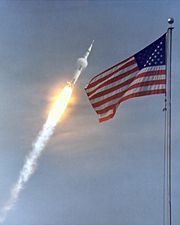 Criterion became very successful with the lines of telescopes that they developed. Over the years under the original management they added more sophisticated and larger models. Their numerous ads appeared in periodicals including: Sky and Telescope, Review of Popular Astronomy, and Science Digest. By mid 1961 the sales of the RV-6 eclipsed those of their 4 inch telescope and the advertising shifted gradually to focus on the RV-6. Through the 1960’s astronomy fever was at a peak since the space program was in full swing with real heroes and a national purpose. People and screen writers had imagination; television programs about astronauts, space and a bright future were on in prime time including Outer Limits, Twilight Zone, Lost In Space, My Favorite Martian, The Jetsons cartoon, I Dream of Jeannie, and of course Star Trek. NASA’s Apollo 11 landed on the Moon on July 20, 1969 and not long after then the Criterion RV-8 telescope was announced selling in October for $399.95. Soon the focus of advertising shifted to these larger models. Some of the demand by the public for larger telescopes might have been because increasing sky light glow from development and air pollution were reducing the transparency of the suburban skies so that amateur astronomers needed larger telescopes to show more to retain their interest in the hobby.
Criterion became very successful with the lines of telescopes that they developed. Over the years under the original management they added more sophisticated and larger models. Their numerous ads appeared in periodicals including: Sky and Telescope, Review of Popular Astronomy, and Science Digest. By mid 1961 the sales of the RV-6 eclipsed those of their 4 inch telescope and the advertising shifted gradually to focus on the RV-6. Through the 1960’s astronomy fever was at a peak since the space program was in full swing with real heroes and a national purpose. People and screen writers had imagination; television programs about astronauts, space and a bright future were on in prime time including Outer Limits, Twilight Zone, Lost In Space, My Favorite Martian, The Jetsons cartoon, I Dream of Jeannie, and of course Star Trek. NASA’s Apollo 11 landed on the Moon on July 20, 1969 and not long after then the Criterion RV-8 telescope was announced selling in October for $399.95. Soon the focus of advertising shifted to these larger models. Some of the demand by the public for larger telescopes might have been because increasing sky light glow from development and air pollution were reducing the transparency of the suburban skies so that amateur astronomers needed larger telescopes to show more to retain their interest in the hobby.
Left: Old Glory salutes the launch of Apollo 11, the first Lunar landing mission. The Apollo 11 Saturn V space vehicle lifted off from Kennedy Space Center’s Launch Complex 39A at 9:32 AM EDT July 16, 1969 with astronauts Neil A. Armstrong, Michael Collins and Edwin E. Aldrin, Jr. On July 20 their Lunar Landing Module descended onto the Moon touching down at 4:17:40 PM EDT (20:17:40 UTC). Many people around the world paused to share this televised moment live, and many more stayed up to watch Neil Armstrong step off the Lander and onto the Moon at 10:56 PM EDT (2:56 UTC) where he uttered “That’s one small step for [a] man, one giant leap for mankind”. Rarely since then has the world been so similarly united. Audio file is .mpeg format 83,968 bytes. The image size 5,840 bytes.
Click on image to see enlarged view (762,206 bytes).
As interest in space exploration and in the Moon landings rose, so did the demand for good quality amateur telescopes increased. While competing affordable refracting telescopes were coming into the market too, some surprisingly well made in the 1960’s including Tasco, Unitron, etc., there was still a demand for light gathering power and or the economy and overall value that the 6 inch Newtonian telescope provided. And the RV-6 prospered.
But events were conspiring against Criterion, and management failed to grasp these in time to save the company as it had been:
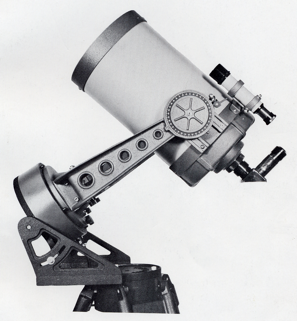 1. By 1970 the American public had largely become used to space missions. When the Apollo 17 mission launched on December 7, 1972 this would be the last manned flight to the moon for that century as the originally planned following three missions had been cancelled as funding had been diverted.
1. By 1970 the American public had largely become used to space missions. When the Apollo 17 mission launched on December 7, 1972 this would be the last manned flight to the moon for that century as the originally planned following three missions had been cancelled as funding had been diverted.
2. A company on the opposite coast had been gaining experience and perfecting the relatively economical mass production of a compact, low maintenance telescope optical tube design. The tube assembly could be made to be as little as ¼ the physical length of a comparable Newtonian optical tube assembly. And the shorter tube length made it possible to provide the telescope on a lighter weight and more intuitive Fork Mount. This company was Celestron Pacific who specialized in the development of the Schmidt-Cassegrain telescopes from 10 inch to as large as 22 inch for government and industry. The company had two people who are largely responsible for their success: Tom Johnson, the optical designer and Alan Hale the business brains of the outfit. By 1970 Celestron struck gold in the amateur market with their introduction of the original Celestron 8, a 23 lb. compact optical tube integrated with a motorized fork mount.
Right: The basic Celestron C-8 Schmidt-Cassegrain telescope with Fork Equatorial mount of 1970; weight 23 lbs. (image size 157,343 bytes).
Criterion either failed to notice the Celestron products in time, or maybe they simply lacked access to an optical source who could consistently make optics that could compete with those of Celestron, but it appears as though Criterion was waiting at the Bus Station when this Ship came in.
3. By 1977 another West Coast company introduced telescopes made off shore including their own 6"f8 Model 591 Newtonian Reflector with a motorized German Equatorial Mount. And later they hired employees with good Newtonian telescope making experience from another recently failed venture and began to produce telescopes that at first resembled the Criterion reflecting models, their first were the Meade 6 inch f/8 Model 628 and 8 inch f/6 Model 826. The Meade Model 826 is such a fine Newtonian that Company Seven keeps one of these too in our museum collection alongside our RV-6. But soon after Meade Instruments went into the business of making these telescopes they improved upon them rapidly. And they employed techniques and business acumen that provided these telescopes were priced competitively with the Criterion.
By the Spring of 1977 the RV-6 prices had increased to $249.00. This seemed to be a fair price, but now it too was having to compete with Celestron’s “C-5” 5 inch Catadioptric telescope. The bulk, weight and comparative complexity and higher maintenance of the Newtonian offset the price advantages for most observers, regardless of the fact that the RV-6 could show more sky, and show it better than any C-5. And as prices increased, the RV series lost its appeal among those who were astute.
In 1980 Meade Instruments joined the SCT fray with their own Model 2080 an 8 inch Catadioptric telescope, and later a 4 inch Model 2040, and this put additional pressure on Criterion. The Meade and Celestron telescopes could interchange a broader range of accessories than those of the Dynamax series, and Criterion never matched the output of these competitors for variety or quantity of accessories, and this too diminished the attractiveness of the Dynamax to the informed shopper.
And the poor condition of the US economy particularly during the Carter presidency meant there was more and more competition for fewer sales.
In 1981 Criterion still operating in East Hartford, Connecticut ceased to function as an independent company after being sold by the Krewalk family to Bushnell Co. Bushnell were based in Pasadena, California and were a wholly owned division of Bausch & Lomb, Inc. By March of 1982 the last advertisement for the RV-6 appeared offering the telescope for $359.95. This price was higher than the price of the more attractive Meade 6 inch (f/5 and f/8) telescopes. After having been in production since 1959 the RV-6 were no more.
The Demise Of Criterion The remnants of Criterion continued production after the Bushnell and Bausch & Lomb trademarks. The product line and policies had been so eroded in the eyes of management at Company Seven that we had no interest in picking up their products even as we rode the crest of ’Comet Halley’ from 1984 to 1985. We sensed this company was being directed by corporate people who knew the cost of everything, but the value of nothing.
By this time imported instruments (especially from Japan) were gaining U.S. market share, and several U.S. based makers of telescopes were sending more and more work to off shore. The manufacturing of telescopes and optical products continues in East Hartford until in December 1997 when Bausch & Lomb decided to close this facility and focus on other high tech consumer items: sunglasses, contact lenses, and such. And by this time all US manufacturers of good amateur telescopes who operated from the 1950’s through the 1970’s had gone out of business with the exceptions of Celestron International and Meade Instruments. And neither Celestron or Meade would survive as independent US manufacturing companies beyond 2007. Celestron was sold to a Chinese manufacturer, while Meade exported production to Mexico and China; other artifacts of the unfortunate George W. Bush Presidency and of sheer capitalistic greed operating at its short-sighted norm.
There is one noteworthy U.S. company who have endured since 1954, and this is Questar Corporation of New Hope, PA. Known for making the ’Rolls-Royce’ of precision compact telescopes, they have endured since 1954 by not tampering much with what makes a Questar great - and by not having to answer to Wall Street.
| Optical Tube Assembly | German Equatorial Mount and ’Dyn-O-Matic’ Drive System | ||||||||||||||||||||||||||||||||||||||||||||||
|
The Internet continues to evolve and bring the world closer than ever, among the benefits are all the resources that helped one to not only find these telescopes used, or rare parts to make restore them, but also literature. Here are Criterion documents scanned by the host of this site:

Contents Copyright 2008-2009 Company Seven and Criterion Mfg., Inc. - All Rights Reserved


